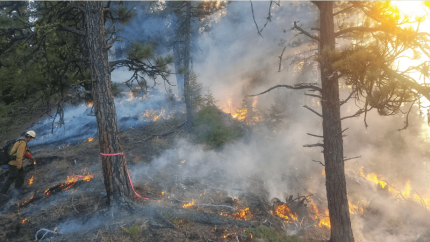
RMEF, Partners Grant $880,000-plus For Washington Wildlife Habitat, Research
THE FOLLOWING IS A PRESS RELEASE FROM THE ROCKY MOUNTAIN ELK FOUNDATION
The Rocky Mountain Elk Foundation and its partners awarded $880,232 of grant funding toward Washington wildlife habitat enhancement and scientific research. RMEF directly granted $306,741 and leveraged an additional $573,491 in partner funding.

“These funds will pay for a variety of treatments including forest thinning, meadow restoration, prescribed burning, noxious weed treatment, aspen restoration and planting nutritional forbs, all to benefit habitat for elk and many other species of wildlife,” said Blake Henning, RMEF chief conservation officer.
Sixteen projects benefit 6,378 acres of elk habitat across Asotin, Chelan, Clallam, Columbia, Garfield, King, Kittitas, Okanogan, Pend Oreille, Pierce, Skamania, Thurston and Yakima Counties.
There are 23 chapters and nearly 15,000 RMEF members in Washington.
“We greatly appreciate the passion and diligence of our volunteers,” said Kyle Weaver, RMEF president and CEO. “It’s due to their efforts of hosting banquets and other fundraising events that these dollars are generated and put back on the ground in their home state.”
Since 1985, RMEF and its partners completed 693 conservation and hunting heritage outreach projects in Washington with a combined value of more than $128.9 million. These projects protected or enhanced 493,523 acres of habitat and opened or improved public access to 129,732 acres.
Below is a list of Washington’s 2020 projects, designated by county.
Asotin County
- Treat noxious weeds across 871 acres on the Chief Joseph and W.T. Wooten Wildlife Areas in the Blue Mountains to improve year-round elk range (also benefits Columbia and Garfield Counties).
- Treat noxious weeds and apply seeding as needed across 300 acres of big game and riparian habitat in the Lower Grand Ronde River watershed, a tributary of the Snake River well-known for its hunting and fishing opportunities. The project benefits land managed by the Pomeroy and Walla Ranger Districts on the Umatilla National Forest, Bureau of Land Management, Chief Joseph Wildlife Area and private landowners.
- Treat noxious weeds across 700 acres of important year-round elk habitat on private lands in the county.
- Treat noxious weeds across 500 acres of winter elk range on privately-owned land adjacent to state-managed public land in the Cougar Creek area of the Lower Grande Ronde Watershed.
Chelan County
- Provide funding for a study to monitor elk movement and habitat use in the upper Stemilt Basin including identifying migration corridors and calving areas. The data will assist wildlife managers to make decisions that protect and improve critical habitat including land exchanges, the location and timing of forest health treatments, and seasonal trail closures.
Clallam County
- Thin dense forests and implement planting and seeding across 325 acres in the Hood Canal Ranger District on the Olympic National Forest. The project improves forest health, facilitates animal movement and opens the forest floor to early seral forage growth while also treating invasive weeds.
Kittitas County
- Thin 1,029 acres of forestland on the Oak Creek Wildlife Area to promote high quality habitat for elk and other wildlife as well as increase forest health and resiliency to natural disturbances.
- Apply noxious weed treatment across 250 acres of previously thinned forestland on the L.T. Murray Wildlife Area in preparation for a second phase of prescribed burning.
- Thin 200 acres of the L.T. Murray Wildlife Area where years of fire exclusion and past harvest practices altered forest structure and composition creating a high risk of uncharacteristic wildfire, insect and disease effects. Removing small diameter trees and opening up the forest canopy will also promote understory pathogens in a changing climate.
Okanogan County
- Plant native forbs and treat noxious weeds in an area previously seeded with a native grass mixture across 300 acres on the Chesaw Wildlife Area, an area serving as both elk spring range and calving grounds.
Pierce County
- Prescribe burn and seed 47 acres, cut back ferns and other competing vegetation on 12 acres, and treat noxious weeds across five acres in the Snoqualmie Ranger District on the Mount Baker-Snoqualmie National Forest. Crews will also erect signage across 21 forage units to inform the public about hunting and wildlife opportunities. Managers hope the signs will discourage trash dumping and direct recreational target shooting to more appropriate areas within the watershed (also benefits King County).
Pend Oreille County
- Lop and scatter encroaching conifers within 210 acres of meadow habitat and aspen stands in the Newport and Sullivan Lake Ranger Districts on the Colville National Forest. Crews will also repair fencing designed to keep livestock away from aspen sprouts and riparian shrubs.
- Thin and prescribe burn 300 acres of big game winter range in the Newport and Sullivan Lake Ranger Districts on the Colville National Forest. The treatments in the Ruby Creek watershed will rejuvenate forage and promote forest wildfire resiliency in an area that historically supported open timber stands with a brush and grass understory. In addition, the improvements may reduce the big game use of private farmlands and livestock feed in the Pend Oreille River Valley.
Skamania County
- Treat a variety of noxious weeds across 616 acres of meadows in the Mount Adams Ranger District on the Gifford Pinchot National Forest, an area that provides important forage for the Mount St. Helens elk herd.
Thurston County
- Apply prescribed burning, brush mowing, seeding and noxious weed treatments to improve 100 acres of wet meadow and oak woodland habitat on the Scatter Creek Wildlife Area’s West Rock Prairie Unit. In addition to elk, the project benefits the recovery of the federally threatened Oregon spotted frog along with several rare butterflies and plants.
Yakima County
- Remove encroaching conifers and invasive plants from 72 acres of meadows in the Naches Ranger District on the Okanogan-Wenatchee National Forest. The South Fork Tieton River area is important calving and summer range for the Yakima elk herd, one of the largest in the state. It also provides key habitat for deer.
Project partners include the Washington Department of Fish and Wildlife; Mount Baker-Snoqualmie, Colville, Gifford Pinchot, Okanogan-Wenatchee, Olympic and Umatilla National Forests; Bureau of Land Management, private landowners and various conservation, sportsmen, local government and civic organizations.





